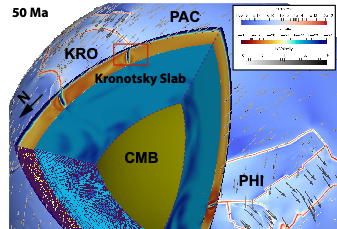The next instalment of the EarthByte seminar series will be held at 11am–12pm Wednesday 27th October, featuring Jiashun Hu from the Southern University of Science and Technology in China. Once again, the seminar will be held online via Zoom, at https://uni-sydney.zoom.us/j/82617614557. For more details, see below:
Formation of the Hawaiian-Emperor Bend and its linkage to the ancient Kronotsky subduction in North Pacific
The Hawaiian-Emperor Seamount Chain changed its strike by 60° around 47 Ma, causing the Hawaiian-Emperor Bend (HEB). Both a change in Pacific Plate motion and a change in the southward drift rate of the Hawaiian Hotspot have been proposed to account for the HEB. We build kinematic plate reconstructions and high–resolution global dynamic models to quantify the amount of Pacific Plate motion change. We find that Izanagi Plate subduction, followed by demise of the Izanagi–Pacific ridge and Izu–Bonin–Mariana subduction initiation alone, is incapable of causing a sudden change in plate motion, challenging the conventional hypothesis on the mechanisms of Pacific Plate motion change. Instead, Paleocene slab pull from Kronotsky intraoceanic subduction in North Pacific exerts a northward pull on the Pacific Plate, with its demise causing a sudden 30-35° change in plate motion. We further quantify the Hawaiian Hotspot drift using global mantle convection models that incorporate this alternative reconstruction with Kronotsky subduction. When combined with Pacific Plate motion change, the drifting hotspot predicts a hotspot track that resembles the Hawaiian-Emperor Seamount Chain. We suggest the Pacific Plate motion change and southward hotspot drift could have contributed nearly equally to the formation of the HEB.

![]()
